Subtotal: $135.00
Midsole of a Shoe: Every Athlete Should Know This!
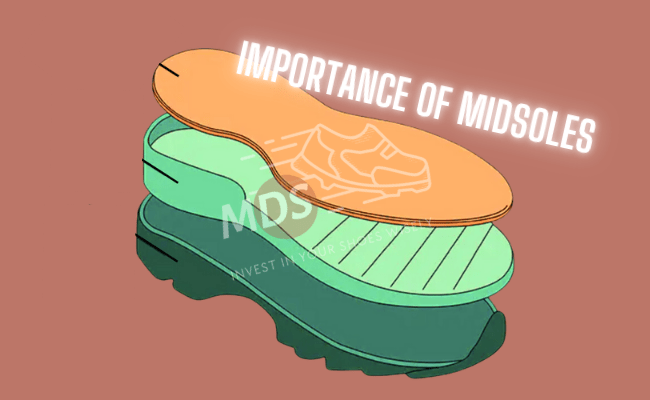
This May, I went to visit my friend living in Toronto. From going to the Niagra Falls to playing Soccer and Cricket in his backyard, we did it all.
But that was not the only highlight of my trip.
When visiting his home, I was wearing my Puma Jamming 2.0 One8 Training shoes. These shoes are comfortable, go well with my loose-fit H&M jeans, and their white color makes me feel clean and bright. When I reached his home, I changed these with my Echo Clog Crocs and sat down to relax.
However, the next time I wore my Puma pair for pub-hopping, I could feel some kind of discomfort in my feet. It almost felt like the sole was pushing the base of my feet, and that too at random points.
This made walking and standing really uncomfortable (fortunately, running was not required).
Somehow, the night passed by and I came back home to take these off—but, I was curious—what happened to my almost perfect Puma kicks? 🙁
Well, the midsole of the shoe had acquired too much moisture, which made it swell and disturb my wearing experience.
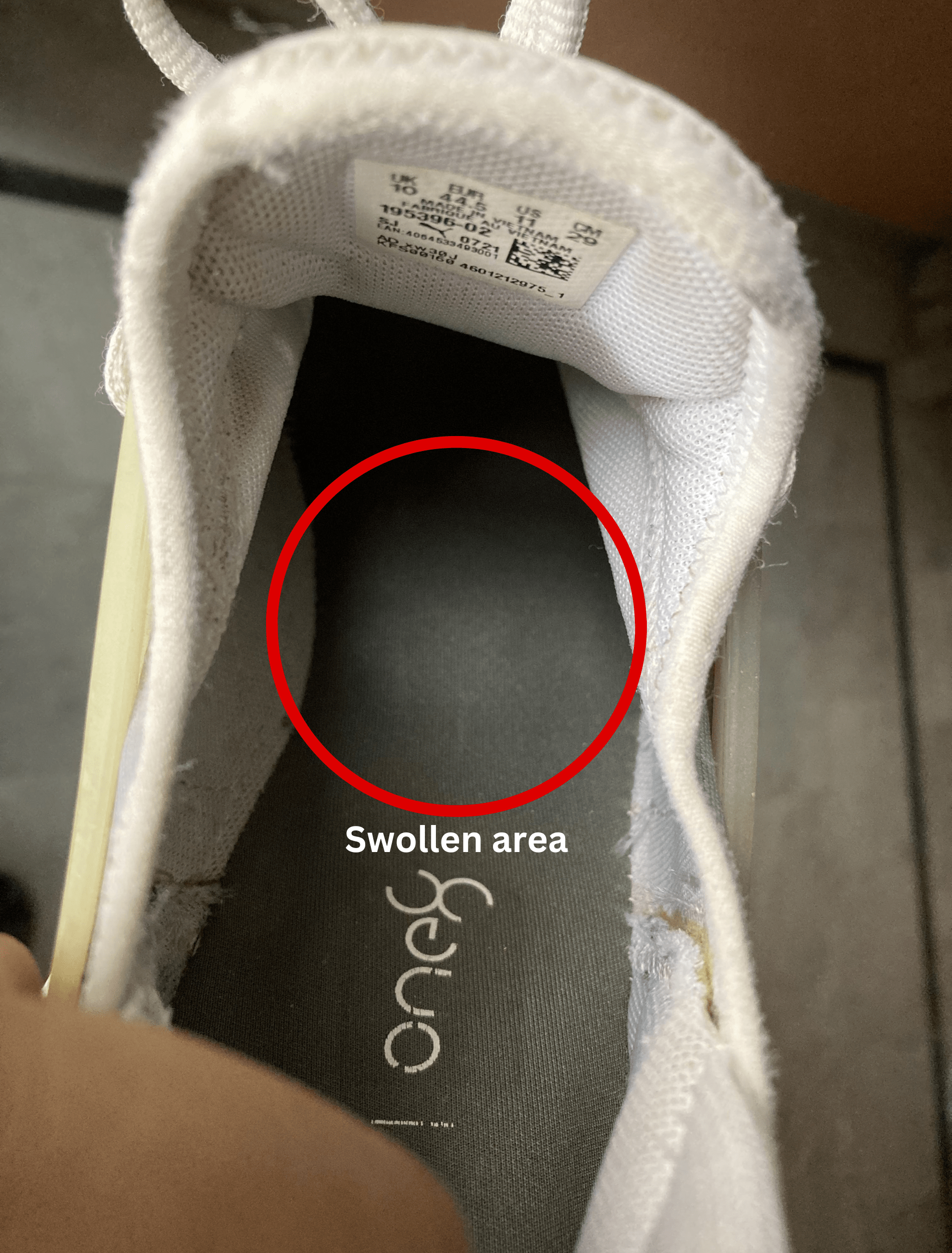
While this little bump may look harmless, it made every step painful and uncomfortable for me. Plus, the stitches around the soles made it difficult to get it out and replace it—so, I had to take it to the Puma store. Finally, they helped me revive my shoes.
But, this wouldn’t have been possible without the right knowledge about midsoles. This is one reason why every athlete and shoe-wearing person must understand the midsoles on their shoes, and that’s what I’m trying to help you with through this article. Here’s a detailed guide on the midsole of shoes and why every athlete must know about it.
First things first, what is a midsole?
A midsole is the layer of material in a shoe that lies between the insole and the outsole. It’s usually made of foam, rubber, or leather (depending on the shoe type), and its primary function is to offer cushioning and support for the feet.
You can locate the midsole in the shoe parts diagram below. It sits right between the insole and outsole.
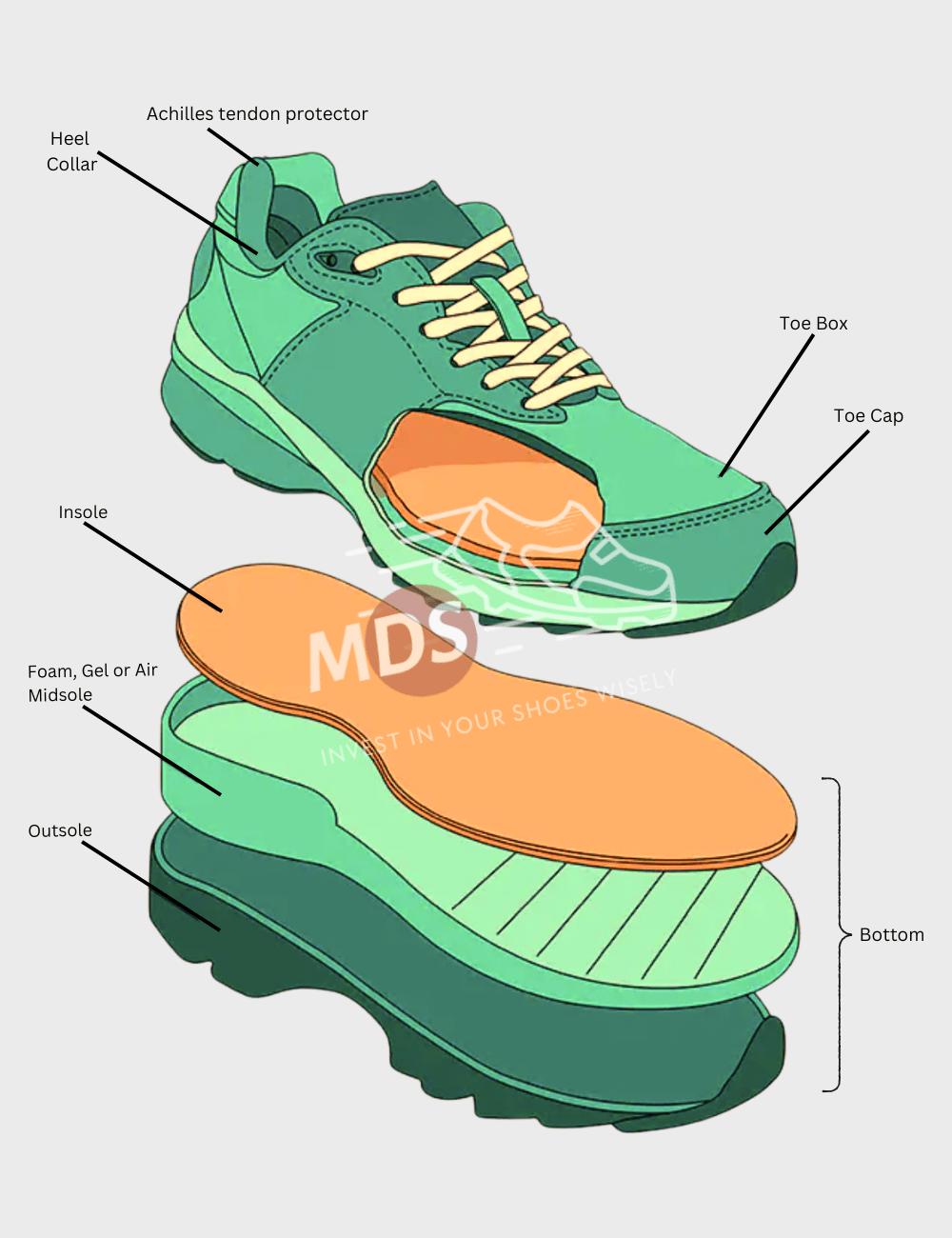
Let’s learn more about the specific purposes your shoes’ midsoles perform.
The game-changing role of midsoles in athletic shoes
Here’s a list of functions that the midsole performs.
Shock absorption and injury prevention
As you go for a run, sprint on the ground, or play a sport, you may need to make quick movements. These movements could often apply a lot of pressure on the impact points where your feet land on the ground.
The soles in your shoes help protect your feet against these impacts.
And the midsole specifically helps absorb all kinds of shocks and sudden impacts by cushioning your foot strikes.
This improves comfort and helps prevent injuries such as shin splints, stress fractures, and joint pain.
To enjoy a comfortable run, you may need to invest in shoes with suitable midsoles.
Enhanced support and stability
Whether you are going for a run or playing an intense game of Lacrosse, your feet need good support and stability.
With appropriate midsole material and design, your feet can feel comfortable and stable, while also enjoying flexibility.
For example, when you wear a shoe with a flat midsole, your toe may collide again with the toe cap, especially while walking downhill. This may give you a toe corn or leave your toe swelling in pain.
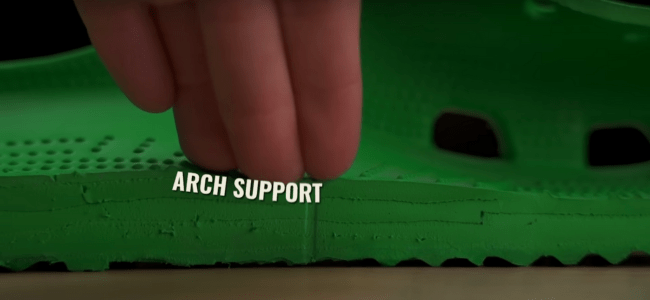
On the other hand, if the midsole of your shoe has an appropriate arch, it will support your feet and prevent your toe from tackling the toe cap.
Energy return for improved performance
Energy return is an important factor for athletic performance, as it pertains to the capacity of the midsole to give back some of the energy expended by the athlete during movement.
The design of your shoe’s midsole can largely determine the energy return it offers, also impacting the performance and fatigue that an athlete faces.
For example, Asics Superblast and Asics Novablast shoes are equipped with a midsole that offers great energy return, allowing athletes to launch quicker, run faster, and perform better.
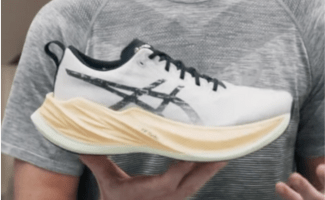
Asics claims that these are their best energy return shoes as they offer the best energy return and help keep athletes going.
Durability and longevity
The shoe’s overall durability also depends on the material of its midsole.
Good-quality midsoles are made to endure repeated strains of sports events while retaining their cushioning and supportive properties.
Plus, when the midsole of a shoe is good and designed appropriately, users can use it for longer periods with comfort and ease. On the other hand, if your “Puma Jamming 2.0 Training shoes” start betraying you on a friendly trip, you may lose confidence and consider changing them.
Materials matter
When it comes to midsoles, high-performance footwear consists of materials such as—EVA (ethylene vinyl acetate), Polyurethane (PU), TPU (Thermoplastic Polyurethane), Boost Foam, Zoom Air and Gel.
With every material performing its unique purpose, different types of shoes can serve different requirements. So, what kind of terrains are Timberland boots suitable for? Or what environments do your Skechers kicks fit best in? Or what can you do with an Adidas Cricup? Well, all of it depends on the type of material and how it has been used in the sole.
EVA (ethylene vinyl acetate)
This is one of the most popular foam types used for making running shoes. Its lightweight and flexibility make it more resilient over long-hauls. Plus, EVA provides an unmatched cushion to the feet. Honestly, while looking for a new pair of running shoes for my office colleague who just moved to LA, we came across Saucony Guide 15 and when I stepped into the shoe, I could feel the softness and comfort in a couple of jumps and brisk walks. While I wouldn’t compare this experience to the one of wearing a Crocs Literide for the first time, these kicks still seemed nearly complete for jogging and running.
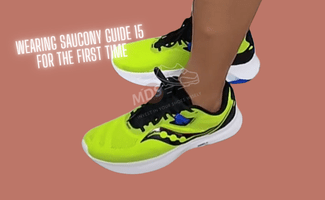
The following factors make EVA shoes so good:
- EVA foam is lightweight and consists of hundreds of compressed bubbles. Each gas-filled bubble is lightweight and offers great foot cushioning and stress absorption.
- EVA is very compressible and easy to handle. The same material may be used for high-density alpine boots and low-density walkers.
- There are various densities at which EVA offers cushioning, as well as support. Plus, the material’s flexibility enables shoe manufacturers to customize the sole to ensure comfort whether it’s a low-density walking shoe or a pair of high-density alpine boots.
No wonder, most shoe manufacturers use EVA midsoles, including:
- Altra Escalante: This running shoe uses an EVA midsole called Altra EGO™, providing a balance between comfort, durability, and responsiveness.”
- Hoka One One Clifton: Famous for its thick EVA midsole, this shoe is a favorite among long-distance runners because it offers maximum cushioning.
PU (Polyurethane)
Shoes with a PU midsole are usually comfortable. While these aren’t especially known for their cushioning, they help ensure the safety of your feet while offering comfort. However, if high-performance athletic shoes are what you are looking for, a PU midsole should be a big no!
Here’s why:
Top boot manufacturers employ polyurethane (polyurethane) for hiking boot midsoles. For example, the Zodiac Plus boots in the image below have a PU foam midsole.
As a result, this can be one of your best bets for hiking.
But, coming from personal experience, I’m pretty sure you don’t want to run with these. In fact, most USA boots employ polyurethane for performance and durability, which makes them unsuitable for running performance.
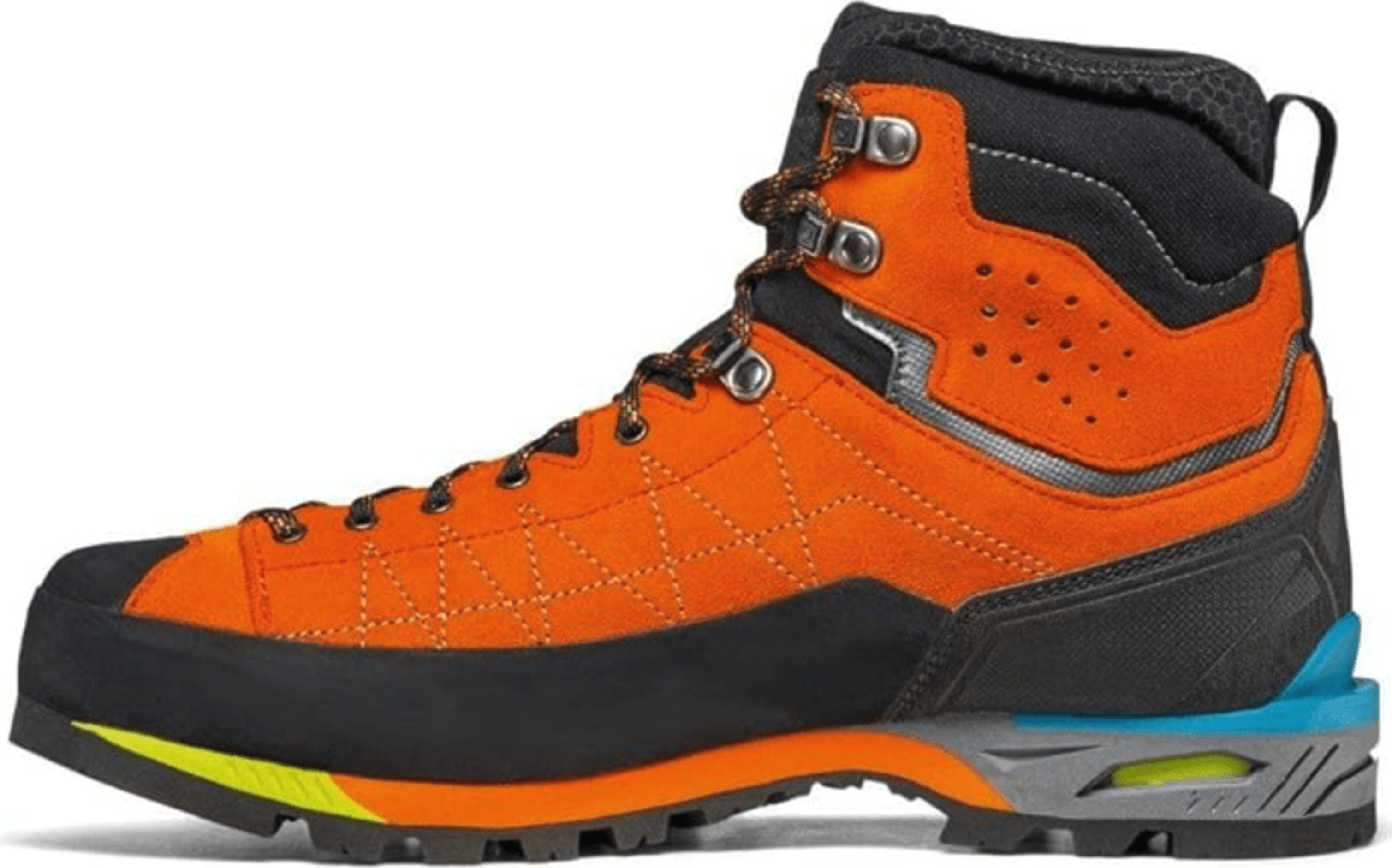
Examples:
- Merrell Moab 2: On rough terrain, this hiking boot comes with a PU midsole that ensures support and stability, enhancing the entire hiking venture.
- Scarpa Zodiac Plus GTX: This boot uses a PU midsole and is perfect for use in alpine conditions and challenging trails.
TPU (Thermoplastic Polyurethane)
TPU is often a part of high-powered running shoes because it combines excellent strength, improved structural support, cushioning properties, and energy return.
It also provides greater resistance to compression compared to EVA foam.
Examples:
- Adidas UltraBoost: This shoe uses TPU pellets melted together to create the Boost midsole which provides unsurpassed energy return and cushioning. This adds a significant amount of comfort and responsiveness to the shoe, making it perfect for professional runners and running enthusiasts.
- Nike Air Zoom Pegasus: One of the most popular shoes among runners who want to find the right combination of comfort and speed, this has TPU built-in for more durability as well as more energy return.
Boost Foam
Boost foam is a technology by Adidas. The foam comprises pellets of TPU fused together to develop it. Boost foam maintains its properties across a range of numerous temperatures, making it the best at providing cushioning and energy return in all conditions.
Examples:
- Adidas UltraBoost 21 is known for its comfortable cushioning and high energy return thanks to the Boost foam in this shoe which makes it suitable for running long distances or regular daily use.
- Adidas NMD is the ultimate sneaker that merges streetwear performance, a sneaker built by using Boost foam that makes it comfortable and supportive to wear all day long.
Zoom Air
Pressurized air units are built into Nike’s Zoom Air system to create responsive cushioning. The result is lightweight and a quick, springy feeling.
Examples:
- Nike Zoom Vaporfly 4%: Used by elite marathoners, this shoe leverages Zoom Air technology to enhance speed and efficiency through responsive cushioning.
- Nike LeBron 17: Designed for basketball, it combines Zoom Air units to provide explosive responsiveness and cushioning needed for high-impact sports.
Gel-Technology
ASICS’ Gel technology uses a silicone-based gel for shock absorption. It’s strategically placed in the midsole to enhance cushioning and comfort.
Examples:
- ASICS Gel-Kayano 27 is popular for its Gel cushioning technology in the heel and forefoot. This guarantees better shock absorption and comfort for long-distance running.
- ASICS Gel-Nimbus It is loved by runners as it utilizes Gel technology in order to offer a smooth and cushioned ride hence preventing exhaustion after running for a long period.
Signs that your midsole needs a replacement
Even the greatest athletic shoes get worn out. And, it’s usually the midsole that gives the first signs of deterioration. For you to be able to keep up with the performance levels, comfort, and injury-free life, it is very important to recognize when your midsole requires substitution. Here are some signs that indicate it’s time to invest in a new pair of shoes:
- You are feeling more strain on your joints during high-impact activities like running or jumping.
- When you engage in activities like running, jumping, or even sitting for long periods of time, you experience increased soreness in your feet, knees, hips, or lower back.
- Visible creases or compression lines indicate that the foam or cushioning material has reached its threshold and needs replacement.
- If the midsole does not spring back or looks permanently squashed, it’s time to change it.
- Put the shoes on a flat surface. Uneven midsole wear causes shoes to tilt.
- If you use basketball and tennis shoes frequently and intensively, you should replace them every 6–12 months.
- Depending on individual factors such as weight, running style, and terrain, you may need to replace your soles (or even shoes) every 300-500 miles.
- Evaluation of Soccer Cleats and Cross-Training Shoes should be done every season or after about 70–100 hours of play.
Which midsole is suitable for which sport?
The kind of shoes you wear for any sport can largely determine your performance. Here’s an infographic discussing what type of midsole is suitable for which sport.

Marty speaks
Brand names and cool designs do not define athletic shoe selection. The midsole is important depending on different factors that are imperative for performance, feeling at ease, and avoidance of injuries in your life as an athlete.
Knowing the significance of midsoles, what kinds of midsoles exist for specific activities, and the warning signs when you should change them allows you to make better choices that support your athletics.
When you choose the correct midsole for your particular sport or activity, you make sure to reap the benefits of padding, and energy rebound to reach your peak performance.
Whether you are a runner, basket-baller, soccer lover, or professional lawn tennis player, you must remember that everything about your game can change dramatically by simply focusing on the midsole.
The next time you wear your shoes, stop and admire the technology beneath them. Having the perfect midsole is about more than just wearing shoes; it’s about moving on to another level.
FAQs
Now, let’s take a look at some frequently asked questions.
1. How to age midsoles?
One efficient way is exposing the shoes to UV light which includes keeping them out in the open air where the sun directly shines on them, or underneath a UV lamp either for hours or a few days.
2. How does the midsole help in preventing injuries?
By absorbing shocks and cushioning each foot strike, the midsole reduces the impact on your body. This prevents injuries such as shin splints, stress fractures, and joint pain.
3. What materials are commonly used in midsoles?
Midsoles consist of various materials, each offering unique properties:
- EVA (Ethylene Vinyl Acetate): Lightweight and flexible, offering great cushioning.
- PU (Polyurethane): Denser and more durable, providing strong support.
- TPU (Thermoplastic Polyurethane): Combines strength, support, and energy return.
- Boost Foam: Developed by Adidas, provides excellent energy return and maintains cushioning in various temperatures.
- Zoom Air: Nike’s technology uses pressurized air for responsive cushioning.
- Gel: ASICS’ silicone-based gel for shock absorption.

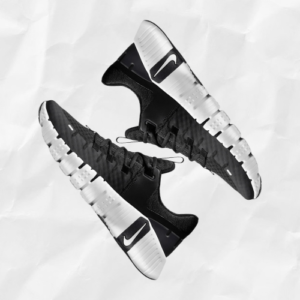 Shop Nike Free Metcon 5 Training Shoes
Shop Nike Free Metcon 5 Training Shoes